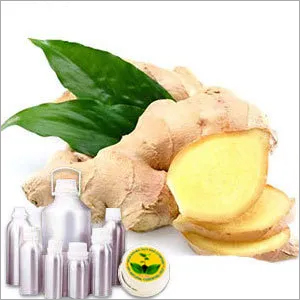Ginger Oil
 | Botonical Name | : | Zingiber officinale |
 | CAS # | : | 8007-08-7 |
 | Country of Origin | : | India |
 | Color & Odor | : | Dark yellow to reddish yellow Clear Viscous Liquid with Warm, spicy odor |
 | Solubility | : | Insoluble in water, soluble in alcohol and oils |
 | F.E.M.A. # | : | 2522 |
 | Specific Gravity | : | 0.8890 0.9120 @ 20°C |
 | Optical Rotation | : | -45° to -27° @ 20°C |
 | Refractive Index | : | 1.4880 “ 1.4990 @ 20°C |
 | Flash Point | : | >100°C |
 | Major Constituents | : | Alpha-Zingiberene, Ar-Curcumene, Beta-Sesquiphellandrene |
 | Plant Part Used | : | Rhizomes |
 | Extraction Method | : | Steam Distillation |
DESCRIPTION:
With having up to ¾ feet length, perennial herb like ginger is basically tube shaped thick rhizome of a medicinal plant. Its rhizome is cut into pieces and is used to obtain and distil oil by applying extreme heat. CONSTITUENTS:
Alpha-Zingiberene, Ar-Curcumene, Beta-Sesquiphellandrene, 1,8-Cineole, Camphene, Beta-Phellandrene AROMATIC SUMMARY / NOTE / STRENGTH OF AROMA:
The middle note fragrance of this essential oil reminds about refreshing smell of garden fresh ginger. BLENDS WITH:
Ginger essential oil can be easily blended with bergamot, rosewood, sandalwood, frankincense, rose, patchouli, coriander, neroli, lime, vetiver, orange and cedar wood.COMMON NAMES:
This scented oil is also referred as Jamaica Ginger oil.USES:
Apart from its applications in aromatherapy, Ginger Oil is used to treat nausea that includes morning sickness and motion sickness; coughs, flue, common cold and rheumatism. The warm smell of this oil helps to relieve joint stiffness, pain, spasm and muscular cramps. 


































